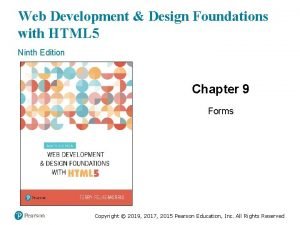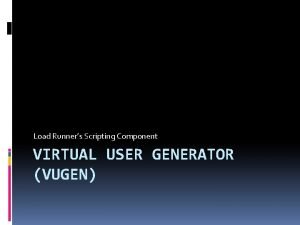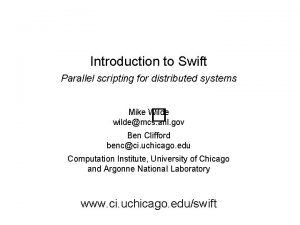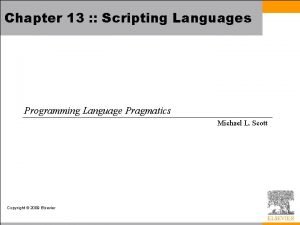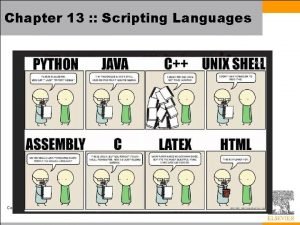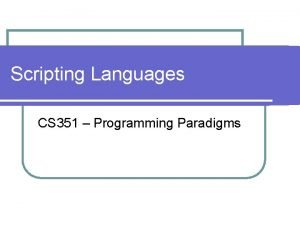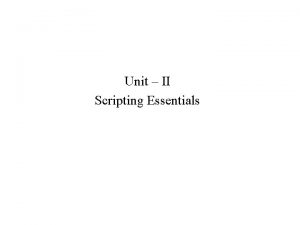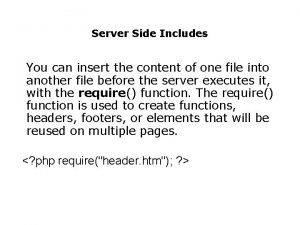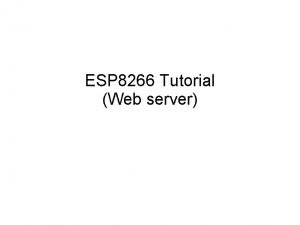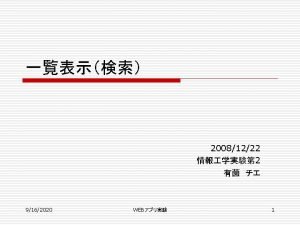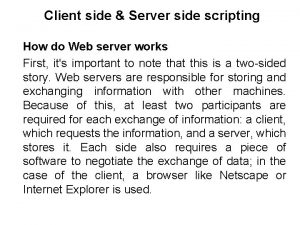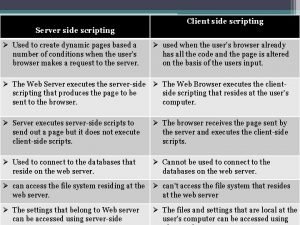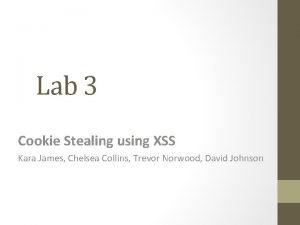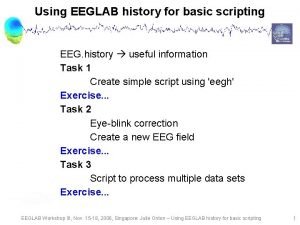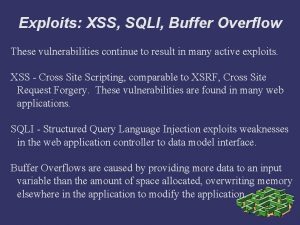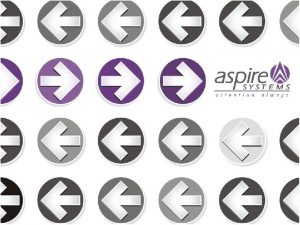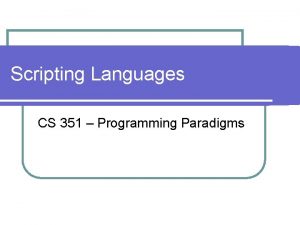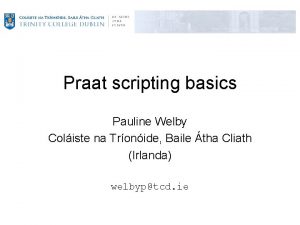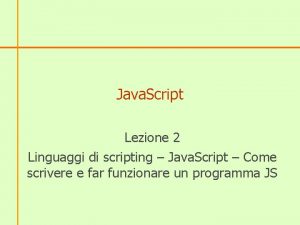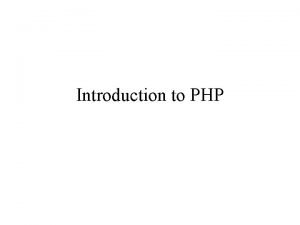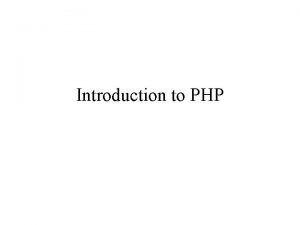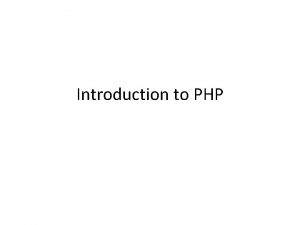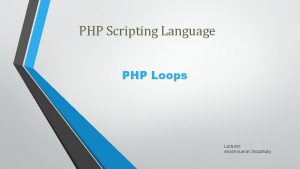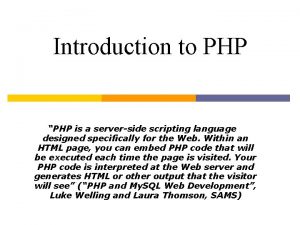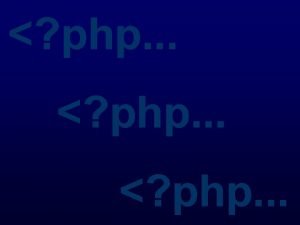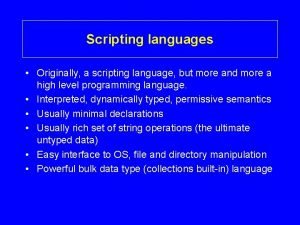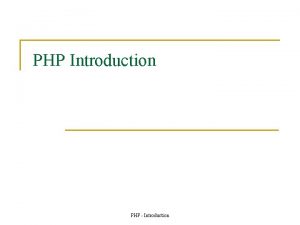PHP Introduction PHP is a server scripting language









































- Slides: 41

PHP

Introduction • PHP is a server scripting language, and a powerful tool for making dynamic and interactive Web pages. • PHP is a widely-used, free, and efficient alternative to competitors such as Microsoft's ASP.


What is a PHP File? • PHP files can contain text, HTML, CSS, Java. Script, and PHP code • PHP code are executed on the server, and the result is returned to the browser as plain HTML • PHP files have extension ". php"

What Can PHP Do? • PHP can generate dynamic page content • PHP can create, open, read, write, delete, and close files on the server • PHP can collect data • PHP can send and receive cookies • PHP can add, delete, modify data in your database • PHP can be used to control user-access • PHP can encrypt data With PHP you are not limited to output HTML. You can output images, PDF files, and even Flash movies. You can also output any text, such as XHTML and XML.

Why PHP? • PHP runs on various platforms (Windows, Linux, Unix, Mac OS X, etc. ) • PHP is compatible with almost all servers used today (Apache, IIS, Mercury, File. Zilla, Tomcat etc. ) • PHP supports a wide range of databases • PHP is free. Download it from the official PHP resource: www. php. net • PHP is easy to learn and runs efficiently on the server side


gfgf

PHP Data Types

PHP 5 Syntax • A PHP script is executed on the server, and the plain HTML result is sent back to the browser. • A PHP script can be placed anywhere in the document. • A PHP script starts with <? php and ends with ? >: • A PHP file normally contains HTML tags, and some PHP scripting code. • PHP statements end with a semicolon (; ).

PHP Case Sensitivity • In PHP, all keywords (e. g. if, else, while, echo, etc. ), classes, functions, and user-defined functions are NOT case-sensitive. • All variable names are case-sensitive.

PHP Variables • A variable can have a short name (like x and y) or a more descriptive name (age, carname, total_volume). Rules for PHP variables: – A variable starts with the $ sign, followed by the name of the variable – A variable name must start with a letter or the underscore character – A variable name cannot start with a number – A variable name can only contain alpha-numeric characters and underscores (A-z, 0 -9, and _ ) – Variable names are case-sensitive ($age and $AGE are two different variables)

PHP is a Loosely Typed Language • We did not have to tell PHP which data type the variable is. • PHP automatically converts the variable to the correct data type, depending on its value. • In other languages such as C, C++, and Java, the programmer must declare the name and type of the variable before using it.

PHP Variables Scope • In PHP, variables can be declared anywhere in the script. • The scope of a variable is the part of the script where the variable can be referenced/used. • PHP has three different variable scopes: – local – global – static

Global and Local Scope • A variable declared outside a function has a GLOBAL SCOPE and can only be accessed outside a function:

Global and Local Scope • A variable declared within a function has a LOCAL SCOPE and can only be accessed within that function:

PHP Data Types • Variables can store data of different types, and different data types can do different things. • PHP supports the following data types: – – – – String Integer Float (floating point numbers - also called double) Boolean Array Object NULL Resource

PHP String • A string is a sequence of characters, like "Hello world!". • A string can be any text inside quotes. You can use single or double quotes:

PHP String • The PHP strlen() function returns the length of a string. • The PHP str_word_count() function counts the number of words in a string: • The PHP strrev() function reverses a string:

PHP String(Search For a Specific Text Within a String) • The PHP strpos() function searches for a specific text within a string. • If a match is found, the function returns the character position of the first match. If no match is found, it will return FALSE. • The example below searches for the text "world" in the string "Hello world!":

Replace Text Within a String • The PHP str_replace() function replaces some characters with some other characters in a string. • The example below replaces the text "world" with "Dolly":

PHP Integer • An integer data type is a non-decimal number between -2, 147, 483, 648 and 2, 147, 483, 647. • Rules for integers: – An integer must have at least one digit – An integer must not have a decimal point – An integer can be either positive or negative – Integers can be specified in three formats: decimal (10 -based), hexadecimal (16 -based - prefixed with 0 x) or octal (8 -based - prefixed with 0)

PHP Integer • In the following example $x is an integer. The PHP var_dump() function returns the data type and value:

PHP Data Types • A float (floating point number) is a number with a decimal point or a number in exponential form. • A Boolean represents two possible states: TRUE or FALSE. • An array stores multiple values in one single variable. • Null is a special data type which can have only one value: NULL.

PHP Object • An object is a data type which stores data and information on how to process that data. • In PHP, an object must be explicitly declared. • First we must declare a class of object. For this, we use the class keyword. A class is a structure that can contain properties and methods:

PHP Resource • The special resource type is not an actual data type. It is the storing of a reference to functions and resources external to PHP. • A common example of using the resource data type is a database call.

PHP Constants • A constant is an identifier (name) for a simple value. • The value cannot be changed during the script. • A valid constant name starts with a letter or underscore (no $ sign before the constant name). • To create a constant, use the define() function. • Constants are automatically global and can be used across the entire script.

PHP Constants • Syntax – define(name, value, case-insensitive) • Parameters: – name: Specifies the name of the constant – value: Specifies the value of the constant – case-insensitive: Specifies whether the constant name should be case-insensitive. Default is false

PHP Constants • The example below creates a constant with a case-sensitive name: • The example below creates a constant with a case-insensitive name:

PHP Operators • Operators are used to perform operations on variables and values. • PHP divides the operators in the following groups: – Arithmetic operators – Assignment operators – Comparison operators – Increment/Decrement operators – Logical operators – String operators – Array operators

PHP Arithmetic Operators • The PHP arithmetic operators are used with numeric values to perform common arithmetical operations, such as addition, subtraction, multiplication etc.

PHP Assignment Operators • The PHP assignment operators are used with numeric values to write a value to a variable. • The basic assignment operator in PHP is "=". It means that the left operand gets set to the value of the assignment expression on the right.

PHP Conditional Statements • Very often when you write code, you want to perform different actions for different conditions. You can use conditional statements in your code to do this. • In PHP we have the following conditional statements: – if statement - executes some code if one condition is true – if. . . else statement - executes some code if a condition is true and another code if that condition is false – if. . . elseif. . else statement - executes different codes for more than two conditions – switch statement - selects one of many blocks of code to be executed

The PHP switch Statement • Use the switch statement to select one of many blocks of code to be executed.

PHP Loops • Often when you write code, you want the same block of code to run over and over again in a row. Instead of adding several almost equal code-lines in a script, we can use loops to perform a task like this. • In PHP, we have the following looping statements: – while - loops through a block of code as long as the specified condition is true – do. . . while - loops through a block of code once, and then repeats the loop as long as the specified condition is true – for - loops through a block of code a specified number of times – foreach - loops through a block of code for each element in an array

The PHP while Loop • The while loop executes a block of code as long as the specified condition is true.

The PHP do. . . while Loop • The do. . . while loop will always execute the block of code once, it will then check the condition, and repeat the loop while the specified condition is true.

PHP Functions • The real power of PHP comes from its functions; it has more than 1000 built-in functions. • Besides the built-in PHP functions, we can create our own functions. • A function is a block of statements that can be used repeatedly in a program. • A function will not execute immediately when a page loads. • A function will be executed by a call to the function.

PHP Functions • A function name can start with a letter or underscore (not a number). • Give the function a name that reflects what the function does! • Function names are NOT case-sensitive.

PHP Function Arguments • Information can be passed to functions through arguments. An argument is just like a variable. • Arguments are specified after the function name, inside the parentheses. You can add as many arguments as you want, just separate them with a comma.

 Server side scripting
Server side scripting Introduction to scripting languages
Introduction to scripting languages Language
Language Loadrunner scripting language
Loadrunner scripting language Swift scripting language
Swift scripting language Language
Language Innovative features of scripting language
Innovative features of scripting language Common characteristics of scripting languages
Common characteristics of scripting languages What is scripting
What is scripting Interpreted language vs compiled language
Interpreted language vs compiled language Lumerical scripting language
Lumerical scripting language Server side includes php
Server side includes php Esplorer tutorial
Esplorer tutorial Web.facebook.com /profile.php
Web.facebook.com /profile.php Php php://input
Php php://input Inventor scripting
Inventor scripting Shell in operating system
Shell in operating system Gel script
Gel script Advantages of client side scripting
Advantages of client side scripting Client-side scripting examples
Client-side scripting examples Tabular editor
Tabular editor Elongday
Elongday Sage 100 scripting
Sage 100 scripting Paraview python scripting
Paraview python scripting Cookie stealing using xss
Cookie stealing using xss Eeglab redraw
Eeglab redraw Common cause of buffer overflow cross-site scripting
Common cause of buffer overflow cross-site scripting Scripting image
Scripting image Scripting image
Scripting image Neoload scripting
Neoload scripting Java scripting
Java scripting Linear scripting framework
Linear scripting framework Microsoft agent scripting helper
Microsoft agent scripting helper Shifting script ideas
Shifting script ideas What is scripting
What is scripting Tronide
Tronide Jmp scripting
Jmp scripting Papercut print scripting
Papercut print scripting Papercut job tickerting print management
Papercut job tickerting print management Marketo tokens
Marketo tokens Linguaggi di scripting
Linguaggi di scripting Papercut uwl
Papercut uwl
